March 6.
On the plane after slow security process. High point of the trip so far was the TSA guy stopping me as I tried to go through with my shoes on. When I told him I was 75, he said I didn’t look it. Tipped him five bucks.
Given what we’re used to, the 8-hour flight to Madrid, business class is a piece of cake. And it actually turns out to be only seven hours. As I have trouble sleeping, I decide to try Ambien, which maybe works a bit, or at least makes you groggy.
Landing in Madrid, I’m confronted by an existential question. Does one walk on a moving walkway, or just stand there. Carol and I, predictably, resolve this question differently. I’m a stander. Since there are about seven miles of moving walkways in our portion of the Madrid airport, Carol has had time to shop, go to the bathroom and eat breakfast by the time I arrive.
Still I believe that there are at least two advantages to my approach. First, I have conserved energy. Thus if we were to encounter, say, a cougar en route to the gate, I’d be better able to fight it off (though, of course, I’d protect Carol from the cougar, too. She relies on me for things like that). And, second, if one believes that moving walkways have feelings (and I believe that with so many moving walkways around the world, that at least some likely do), I’ll have made my moving walkways feel more useful for having carried me along unaided. Travel affords one the opportunity to contemplate issues like this.
In Madrid we have a couple hours layover before continuing on the 3-hour flight to Casablanca, arriving there around noon. After fast-track assistance through the airport, we meet Younes, our guide, who will accompany us for the first six days of our trip in Morocco and our driver, who, helpfully, is also named Younes.
Younes Darif, is a registered and very experienced guide who takes tourists both throughout the cities and countryside. He grew up in and still lives in the UNESCO World Heritage City of Fes. His childhood was spent in the Medina and now he lives in the new modern part of Fes. All of his schooling was done in Fes and he graduated from University with a Bachelor’s Degree. He commenced his Master’s Degree but has deferred its completion temporarily while he takes the chance to travel and gain life experiences. A few years ago he spent time in the USA, working and traveling. His career as a guide in Morocco has been lengthy and he has traveled to every part of this country showcasing it to people of all nationalities. He has in-depth knowledge and a special interest in Jewish Heritage and Islamic Art. In his spare time, when he is not playing with his dog, he tries to read further on these subjects and keep up with world politics.
Originally modeled after Marseilles when the French landed in Casablanca in 1907, Casablanca is the most European of Morocco’s cities and is known as a huge metropolis where modernity and tradition coexist. The city’s French colonial legacy is seen in its downtown architecture, a blend of the old Moorish style and European art deco.
We are staying at Le Doge, which is the epitome of the Art Deco architecture of 1930’s Casablanca – perhaps considered the heyday of this ‘gateway’ to Africa of the then ‘Inter-zone’. Situated near the cathedral, it is at the heart of the Art Deco district and since it opened in 2003 after three years of restoration, it boasts sumptuous fittings with an eclectic mix of influences from the like of Tamara de Lempicka, F. Scott Fitzgerald, Coco Chanel and Josephine Baker. With just 16 rooms and suites (we have a junior suite), this is an intimate, boutique space to begin our journey. We do have a bit more luggage, though, than on our trip 51 years ago.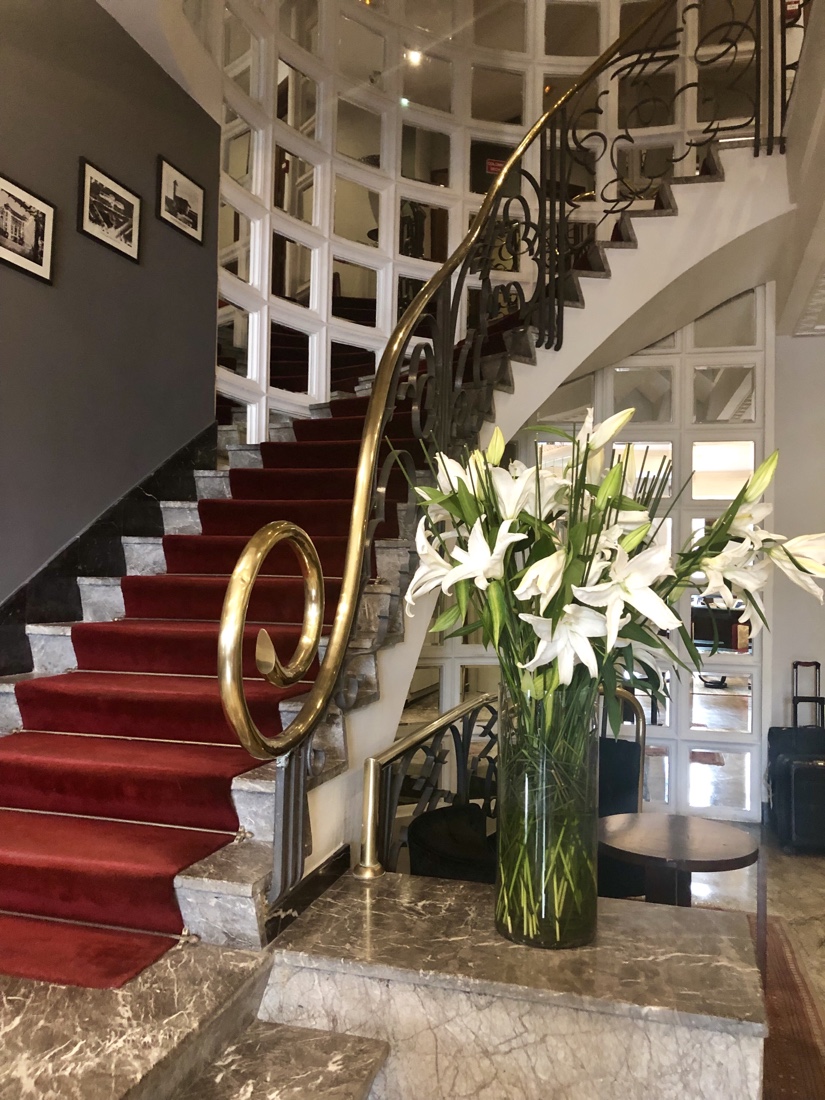 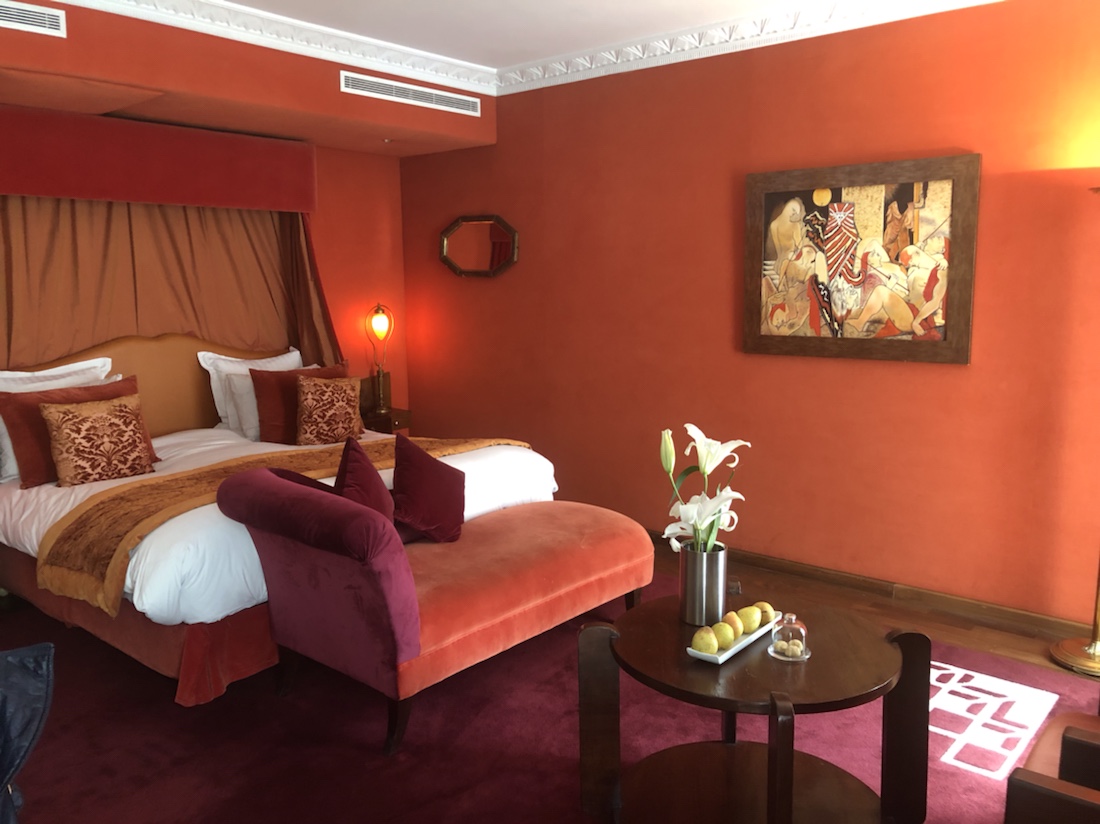 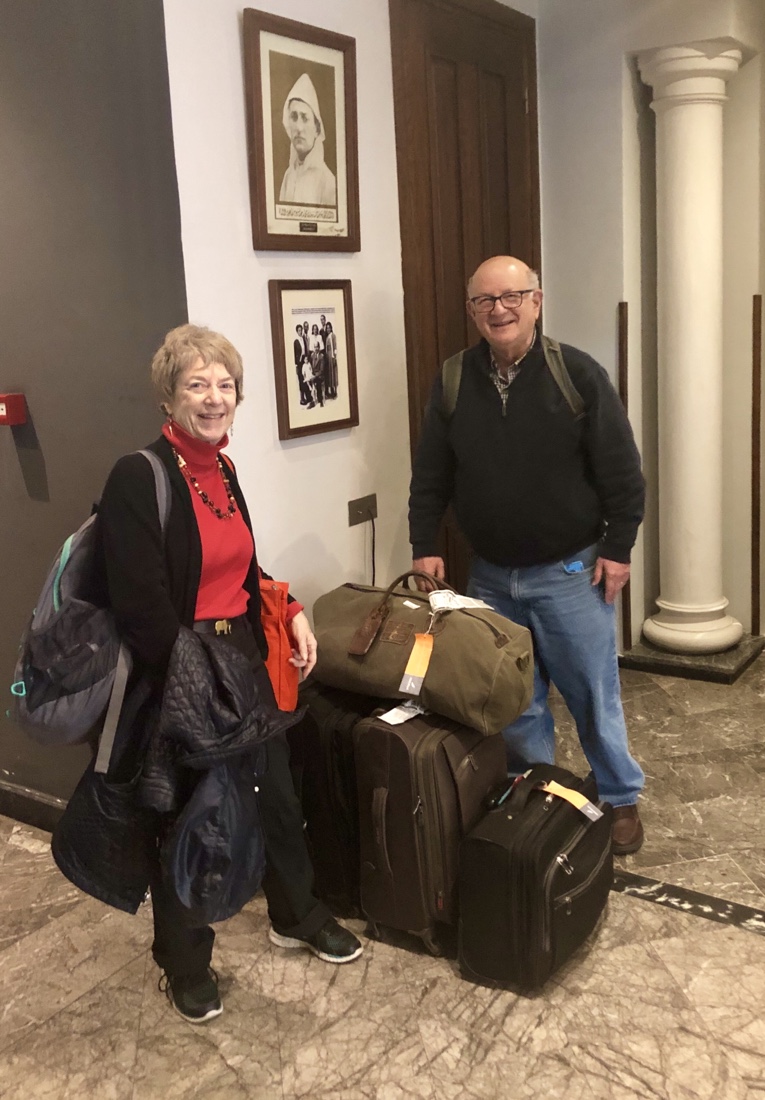
After checking in to Le Doge, we visit the very large Hassan II Mosque, Third largest in the world, after two in Saudi. Built in the late 1980s and early 1990s, it’s quite spectacular, inside and out.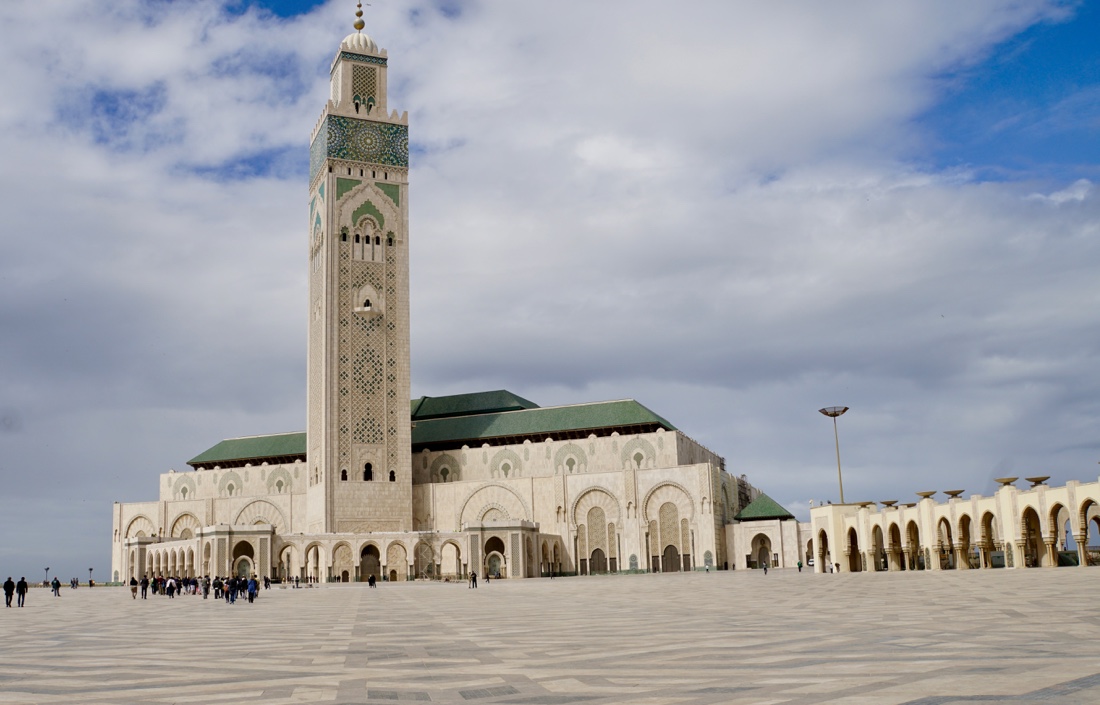 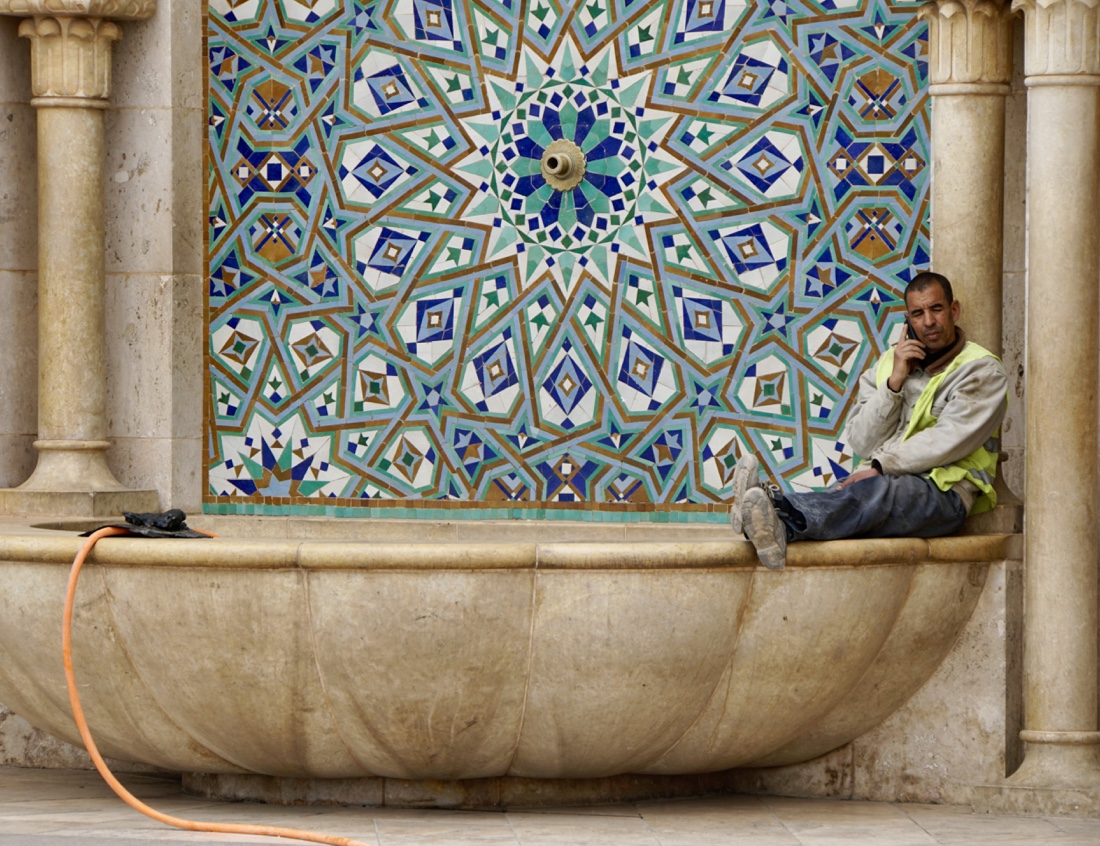 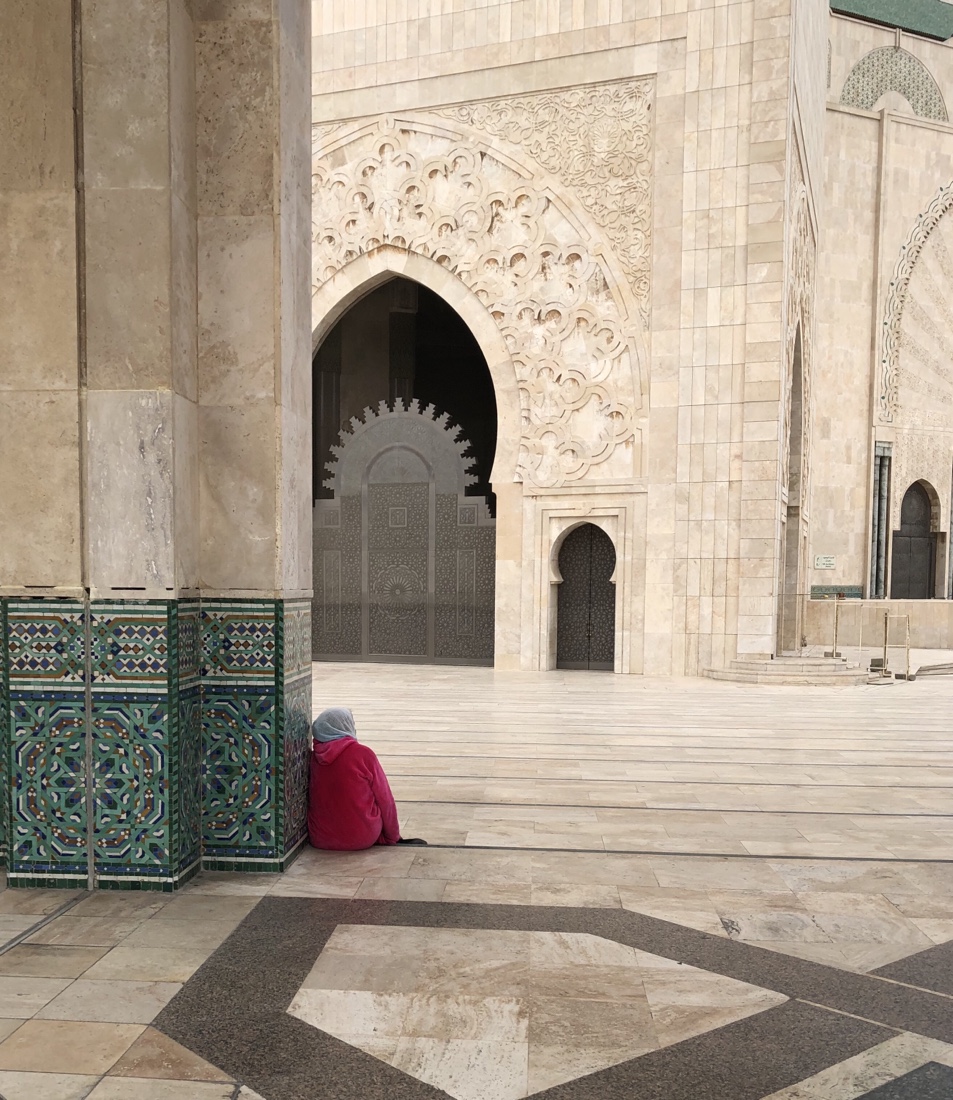 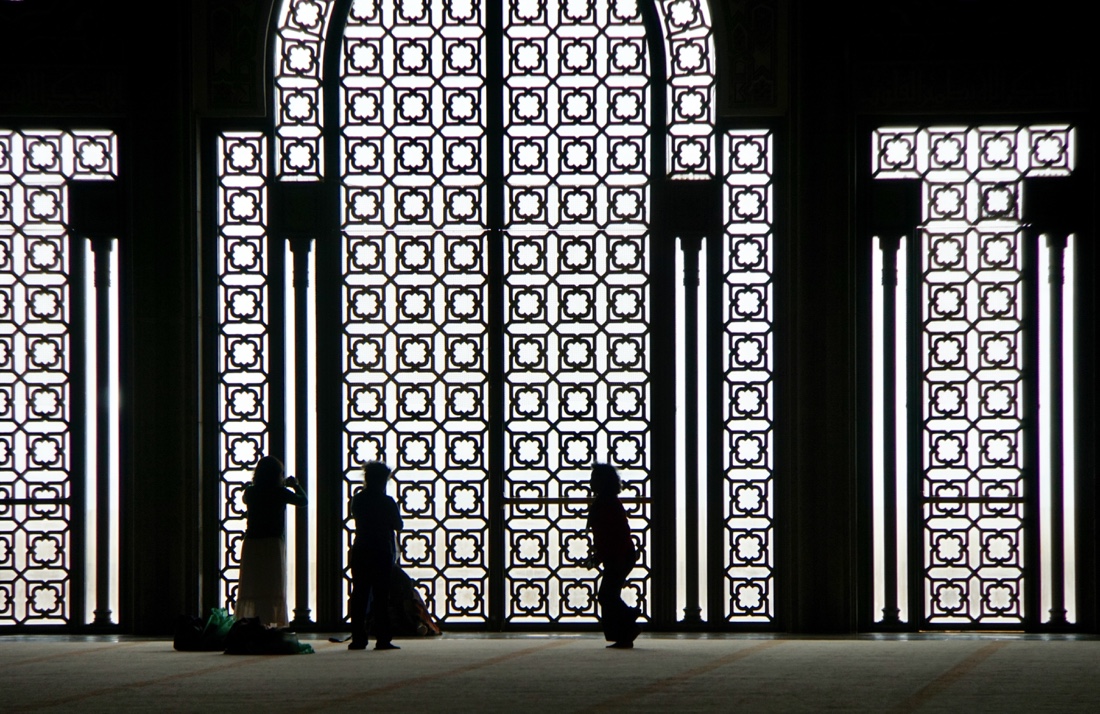 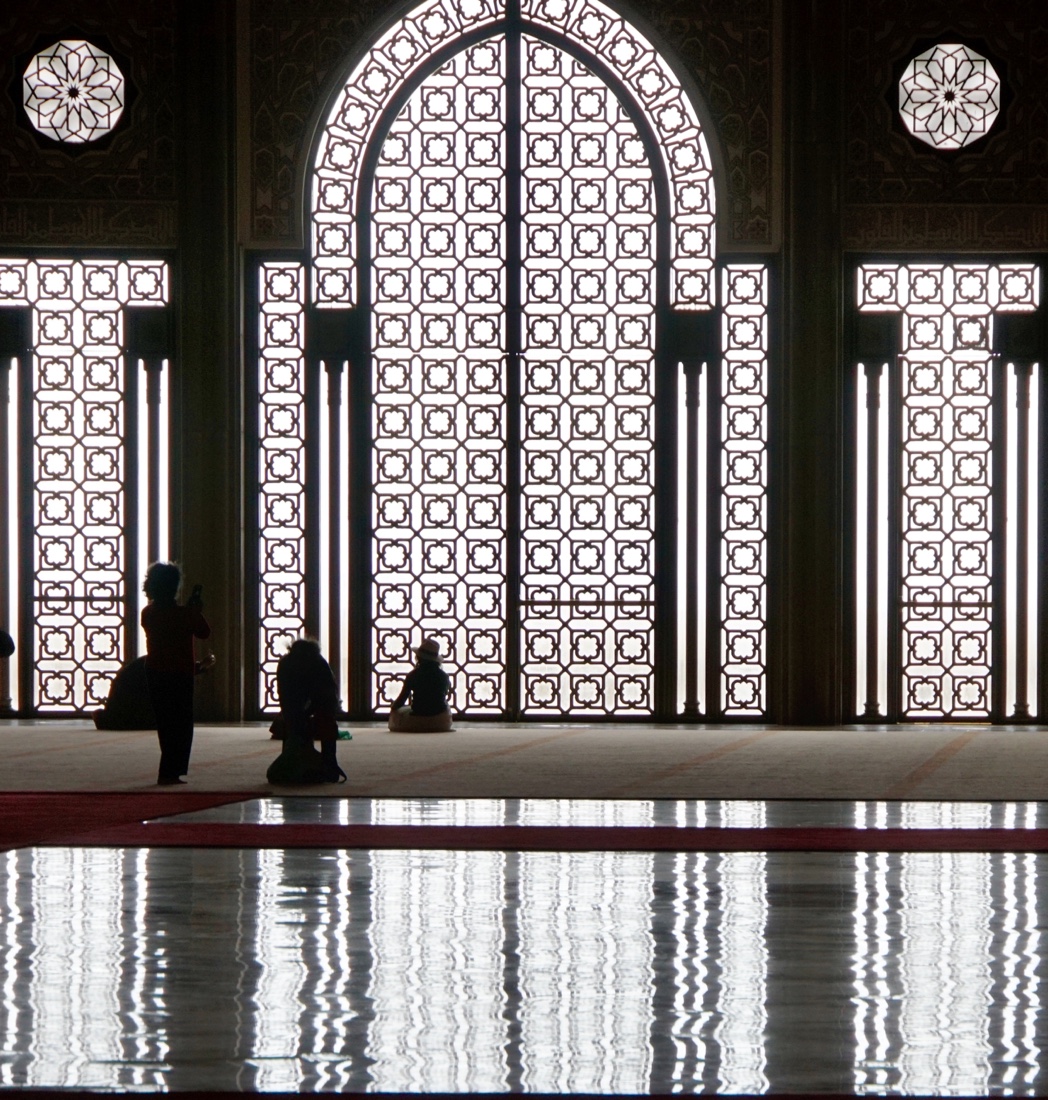
After the mosque, we went to,a church with beautiful stained glass windows, then back to,the hotel for a drink. Dinner tonight by the sea at Le Cabestan, a restaurant recommended to us by our friends, Chet and a Phyllis Handelman, that was just terrific, both the setting and the food. 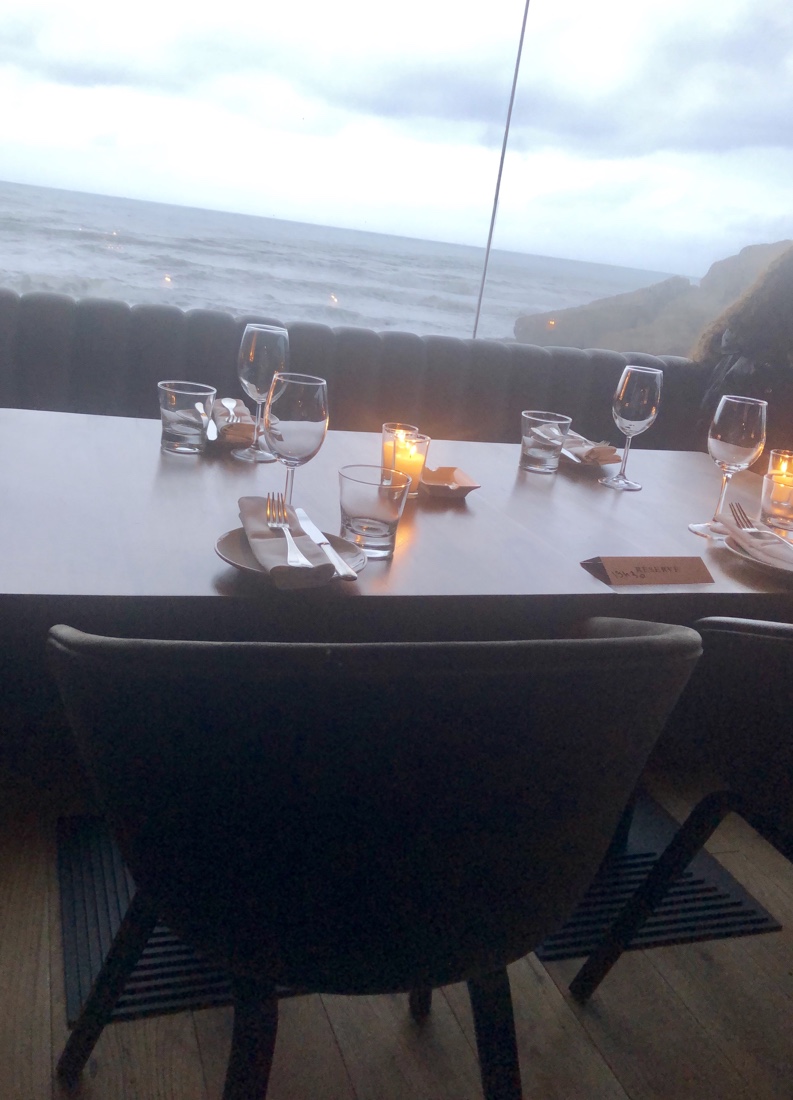 Back to the hotel to sleep and begin to prepare for tomorrow morning’s takeoff. Back to the hotel to sleep and begin to prepare for tomorrow morning’s takeoff.
March 5
Just returned home yesterday afternoon from DC, where we celebrated our grandson, Jasper’s ninth birthday.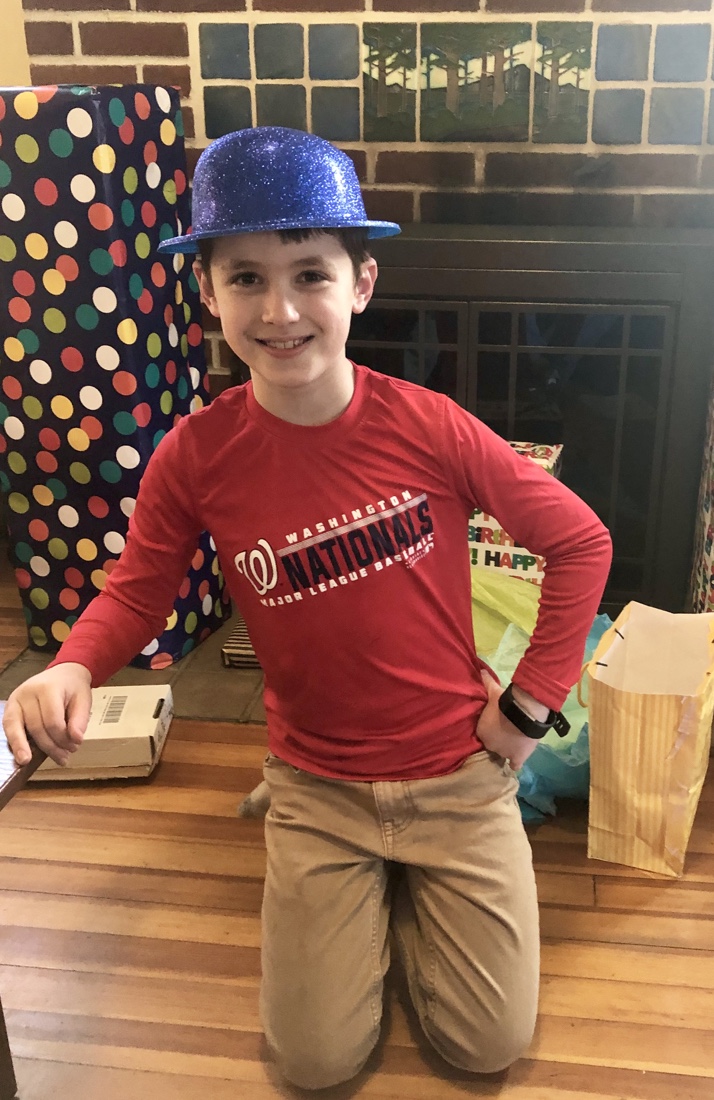
We take off for Morocco in four hours, so here’s a bit of plagiarized background on the country we’re visiting.
Before swamping you with bits of Moroccan history, though, I want to offer this interesting factoid that you can drop at your next cocktail party. Morocco was the first nation to recognize the fledgling United States as an independent nation in 1777. In the beginning of the American Revolution, American merchant ships in the Atlantic Ocean were subject to attack by the Barbary pirates. On 20 December 1777, Morocco’s Sultan Mohammed III declared that American merchant ships would be under the protection of the sultanate and could thus enjoy safe passage. The Moroccan–American Treaty of Friendship, signed in 1786, stands as the U.S.’s oldest non-broken friendship treaty. So there. However, President Trump reportedly is considering invading Morocco, because “I’ve got larger souks than they do,” but has agreed to wait until after we return. Sarah Huckabee Sanders said that the president had meant to say “nukes.”
Morroco is located in the Maghreb of North West Africa with an area of 274,460 sq mi). Its capital is Rabat, the largest city Casablanca. It overlooks the Mediterranean Sea to the north and the Atlantic Ocean to the west. Morocco claims the areas of Ceuta, Melilla and Peñón de Vélez de la Gomera, all of them currently under Spanish jurisdiction. 
Archaeological evidence has shown that the area was inhabited by hominids at least 400,000 years ago. The recorded history of Morocco begins with the Phoenician colonization of the Moroccan coast between the 8th and 6th centuries BCE although the area was inhabited by indigenous Berbers for some two thousand years before that. In the 5th century BCE, the city-state of Carthage extended its hegemony over the coastal areas. They remained there until the late 3rd century BC while the hinterland was ruled by indigenous monarchs. Indigenous Berber monarchs ruled the territory from the 3rd century BCE until 40 CE, when it was annexed to the Roman Empire. In the mid-5th century AD, it was overrun by vandals, before being recovered by the Byzantine Empire in the 6th century.
The region was conquered by the Muslims in the early 8th century AD, but broke away from the Umayyad Caliphate after the Berber Revolt of 740. Half a century later, the Moroccan state was established by the Idrisid dynasty. Under the Almoravid and Almohad dynasties, Morocco dominated the Maghreb and Muslim Spain. The Saadi dynasty ruled the country from 1549 to 1659, followed by the Alaouites from 1667 onwards, who have since been the ruling dynasty of Morocco.
Since the foundation of the first Moroccan state by Idris I in 788 AD, the country has been ruled by a series of independent dynasties, reaching its zenith under the Almoravid and Almohad dynasties, spanning parts of Iberia and northwestern Africa. The Marinid and Saadi dynasties continued the struggle against foreign domination, allowing Morocco to remain the only northwest African country to avoid Ottoman occupation. The Alaouite dynasty, which rules to this day, seized power in 1631.
In 1912, Morocco was divided into French and Spanish protectorates, with an international zone in Tangier. It regained its independence in 1956, and has since remained comparatively stable and prosperous by regional standards. (Note: comparatively stable includes disputes among, Morocco, Spain, France, Algeria and Mauritania.) Morocco claims the non-self-governing territory of Western Sahara, formerly Spanish Sahara, as its Southern Provinces. After Spain agreed to decolonize the territory to Morocco and Mauritania in 1975, a guerrilla war arose with local forces. Mauritania relinquished its claim in 1979, and the war lasted until a cease-fire in 1991. Morocco currently occupies two thirds of the territory, and peace processes have thus far failed to break the political deadlock.
Morocco was a French protectorate from 1912 to 1956, when Sultan Mohammed became king. He was succeeded in 1961 by his son, Hassan II, who ruled for 38 years and played a prominent role in the search for peace in the Middle East. He also ruthlessly suppressed domestic opposition. King Hassan II died in 1999 and was succeeded by his son, Mohammed VI, a cautious modernizer who has introduced some economic and social liberalization.
During the 2011–12 Moroccan protests, thousands of people rallied in Rabat and other cities calling for political reform and a new constitution curbing the powers of the king. In July 2011, the king won a landslide victory in a referendum on a reformed constitution he had proposed to placate the Arab Spring protests. Despite the reforms made by Mohammed VI, demonstrators continued to call for deeper reforms. Hundreds took part in a trade union rally in Casablanca in May 2012. Participants accused the government of failing to deliver on reforms.
The unitary sovereign state of Morocco is a constitutional monarchy with an elected parliament. The King of Morocco holds vast executive and legislative powers, especially over the military, foreign policy and religious affairs. Executive power is exercised by the government, while legislative power is vested in both the government and the two chambers of parliament, the Assembly of Representatives and the Assembly of Councillors. The king can issue decrees called dahirs, which have the force of law. He can also dissolve the parliament after consulting the Prime Ministerand the president of the constitutional court.
Morocco’s predominant religion is Islam, and its official languages are Arabic and Berber; the latter became an official language in 2011, and was the native language of Morocco before the Muslim conquest in the seventh century C.E. The Moroccan dialect of Arabic, referred to as Darija, and French are also widely spoken. Moroccan culture is a blend of Berber, Arab, Sephardi Jews, West African and European influences.
Morocco is a member of the Arab League, the Union for the Mediterranean and the African Union. It has the fifth largest economy of Africa.
Okay, enough for now. See you in Casablanca.
March 4, 2019
Warning: this post may be of a lot more interest to me and our family than it is to you. I’m hoping, though, that friends will be interested in the history of Carol and my wanderlust, because even longtime, close friends may not know how it all came about.
Some folks who I’ve told that we were going to Morocco have asked, “is this your first trip?“ My reply is, “no, we were there before – over 51 years ago.“ Just think about that—51 years ago, and with the very same wife. Pretty amazing, eh?
Our first trip to Morocco was among our early travel experiences, but not the earliest. Our first international trip together was in the summer of 1965, after we were married on June 20 of that year. We took a honeymoon of 11 1/2 weeks traveling around Europe by car (an English Ford Cortina, which I’d surprised Carol by buying from the US, delivered to us at Orly, the Paris airport), and flying to Greece and Israel. There is no question but what our interest in travel was forged by that amazing honeymoon trip of which we still have many fond memories and stories that we might be persuaded to tell you, if you beg us.
Two years later, after I graduated from law school, Carol and I left for a year in London. The ostensible reason for going was so that I could get an advanced degree in law at the London School of Economics. In fact, though, I had no real interest in improving my mind (and I succeeded in not doing that), but wanted to be able to take “a year off,” likely the last opportunity for us to do something like that for a long time. Carol, who had nothing arranged at the time we left, wound up having a terrific professional experience in London, because the Anna Freud Clinic agreed to set up a year’s program geared specifically to her interests. I received an LLM from LSE.
We absolutely loved London and took advantage of all it had to offer, especially theater, concerts, opera and ballet. Through dumb luck we had brought funds over and not converted them to British Pounds, so that when the Pound was devalued, the value of the dollars we’d brought over increased markedly.
My program at LSE included long vacation periods. Since Carol‘s program was geared specifically to her interests, she had great flexibility and was able to take off at the times that I had vacation. As a result, we wound up taking a number of long trips during that year. Among the first of those trips was one to Spain and Morocco over Christmas and New Year’s of 1967-68. We traveled much less expensively and much lighter then than we do these days. Typically, we would take a student flight to the general area that we wanted to explore and then travel around either by hitchhiking or by train or bus. The photo below shows us with our entire combined luggage for the four weeks we spent in Spain and Morocco.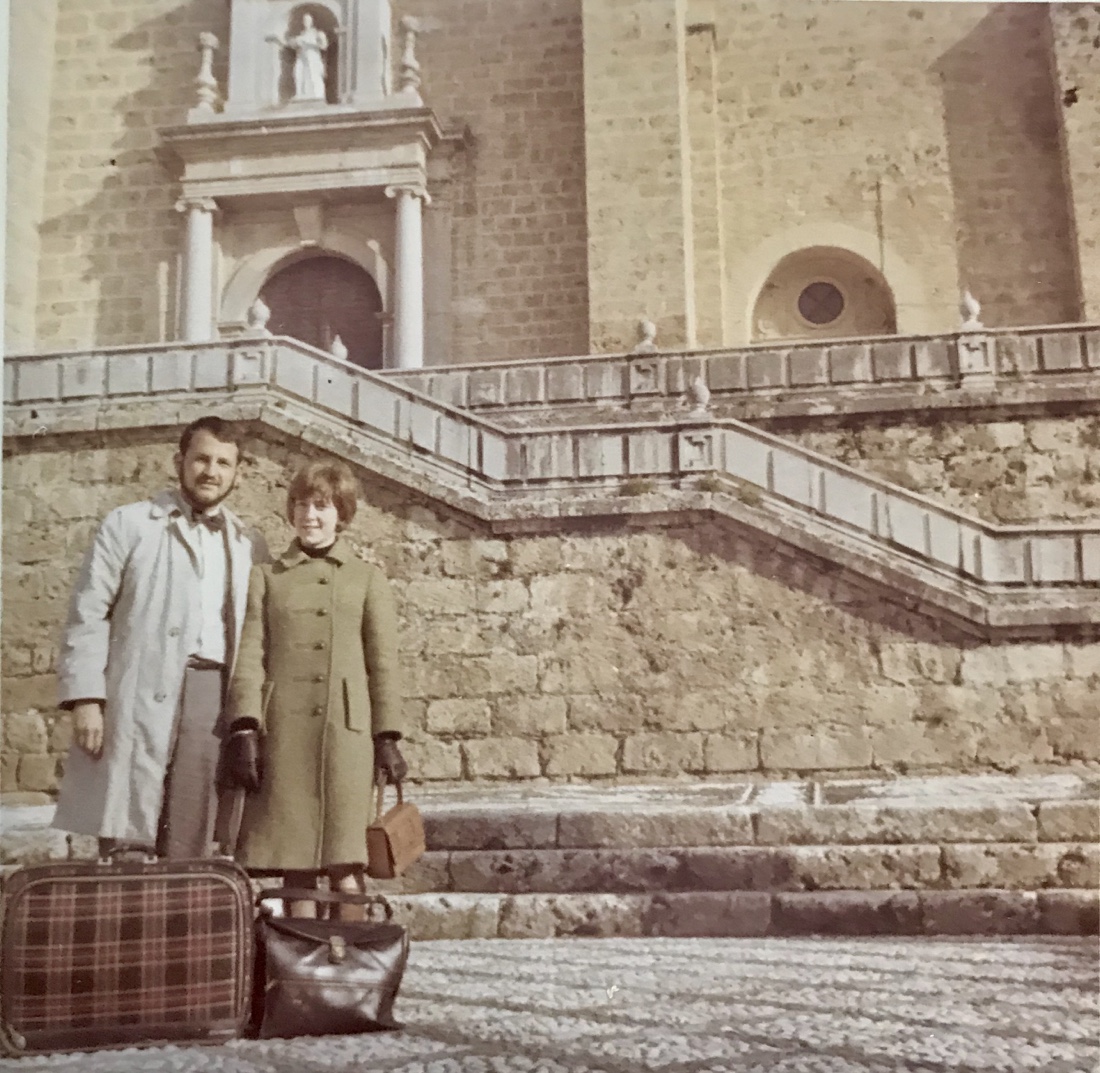
Though the photos have faded, my memories of that trip are very vivid. We made two sets of new friends on the trip. One was a couple about our age, Mike and Diane Dichter, with whom we wound up traveling around Spain, and remained in touch for quite a number of years after that. 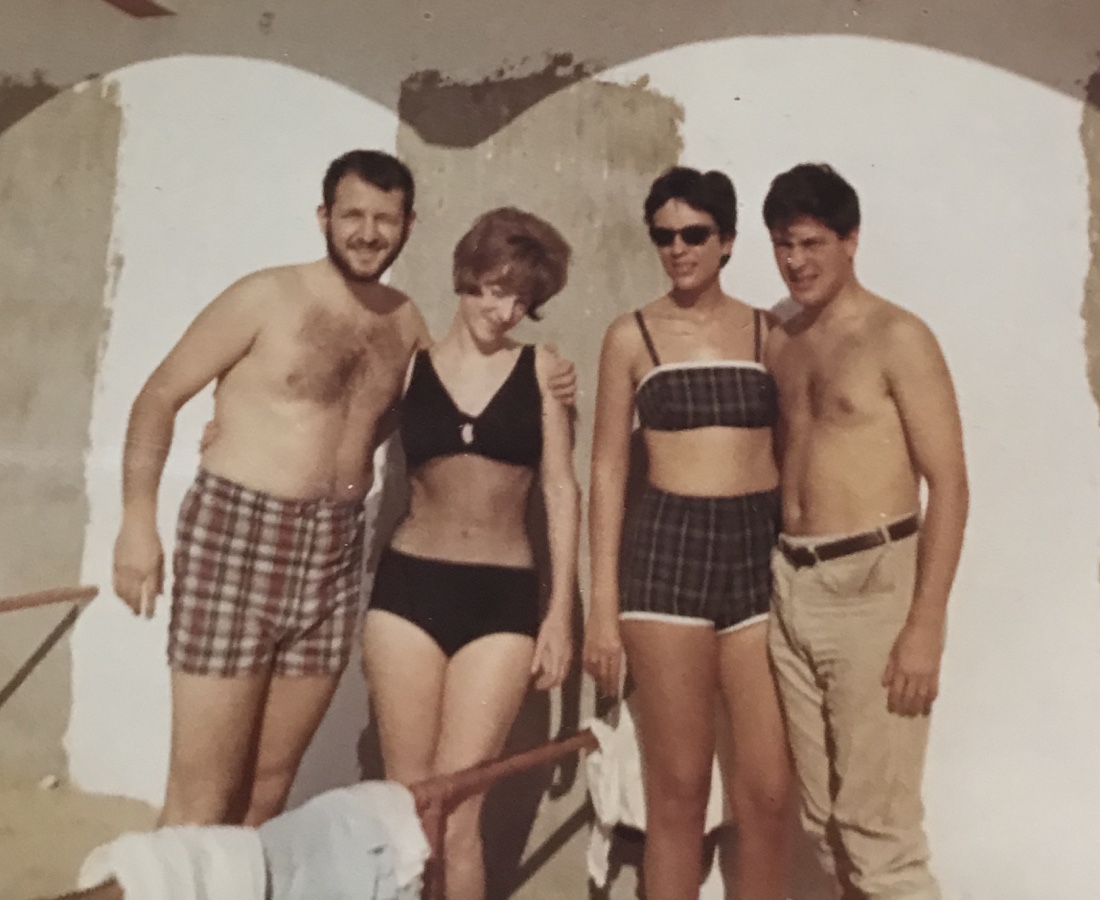
One of the side benefits of travel is that it may encourage you to reconnect. Coming across the above photo caused me to try to track Diane down on the internet. I was successful, and last week we had a terrific dinner with Diane, laughing and reliving some very old memories.
The other couple we connected with on our 1968 trip to Morocco was a more unusual friendship because they were much older than we were. We met Guy and Ruth Armstrong on our flight from Spain to Morocco. They had a rental car and, since we had no specific plans or reservations, when they invited us to travel along with them, we happily agreed. Ruth and Guy lived in California. They were probably approximately the age we are now – which seemed to us to be VERY old indeed. They had met later in life and married. Guy had an undertaking business and Ruth was a grade school principal.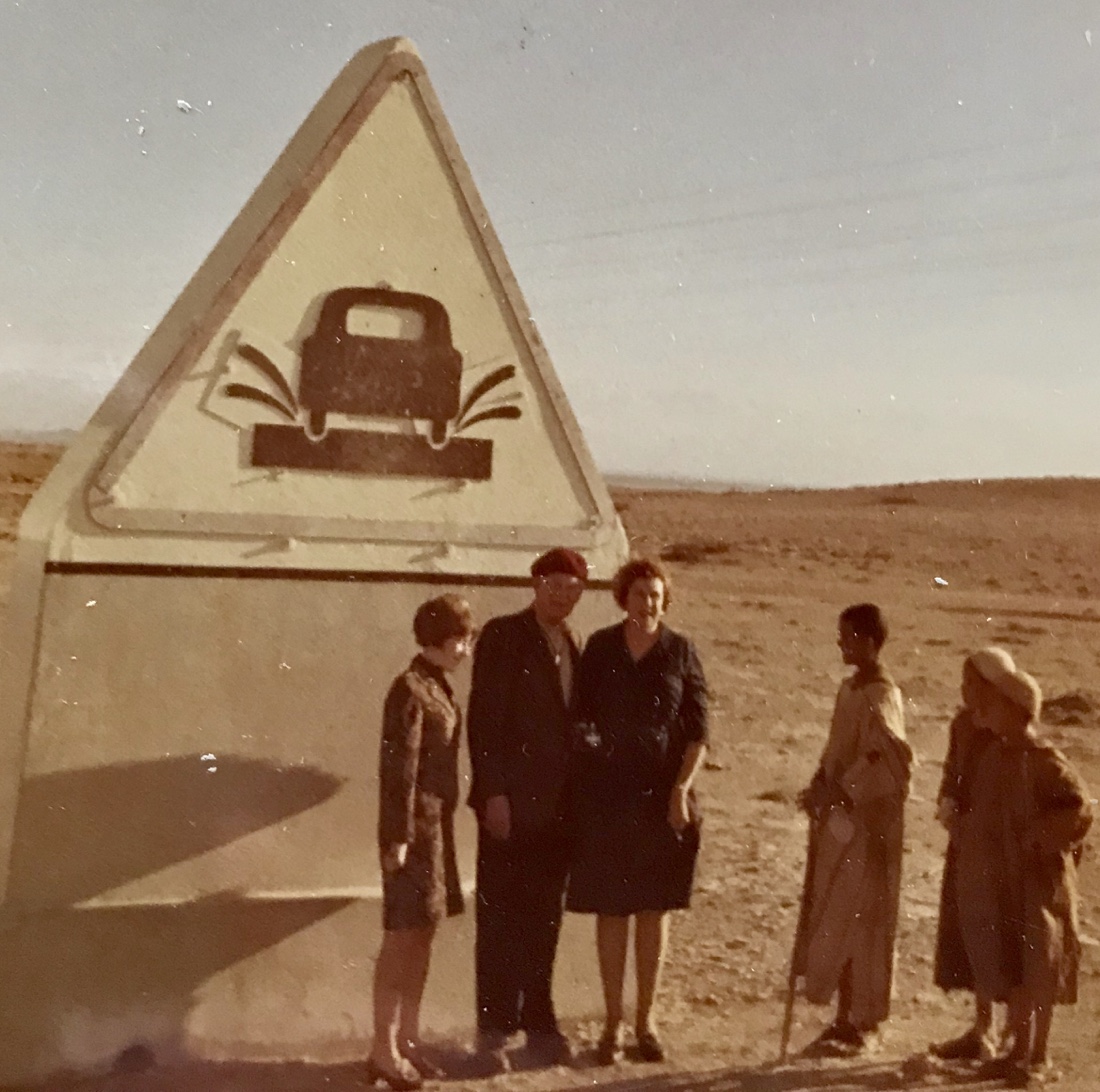
Ruth told us a story that we have repeated countless times over the years. The school that she was the principal of was in a heavily Jewish area in Los Angeles. One of the non-Jewish mothers told Ruth that, at the beginning of the semester, after only a couple days of school, her kindergartner son, Johnny, came home and told her that there was no school tomorrow. The mother, surprised, asked why. Johnny said there was no school because it was a holiday, New Year’s. “Oh,” the mother said, “but that’s not our holiday, so you will be going to school.” Johnny said, no, he wasn’t going, it was a holiday. His mother insisted, though, that, since it was not HIS holiday, he needed to go. Johnny became very upset and said, loudly, “I am NOT going to school tomorrow. If I go, there will only be me and one other reptile there.”
Despite our big age difference, we got along well with Ruth and Guy, who pretty-much adopted us. We’d drive into a city, they’d go to the first class hotel they’d booked and Carol and I would find a spot for about $5. Here is a photo of Carol and me in the gardens of the hotel that the Armstrongs stayed in in Marrakech.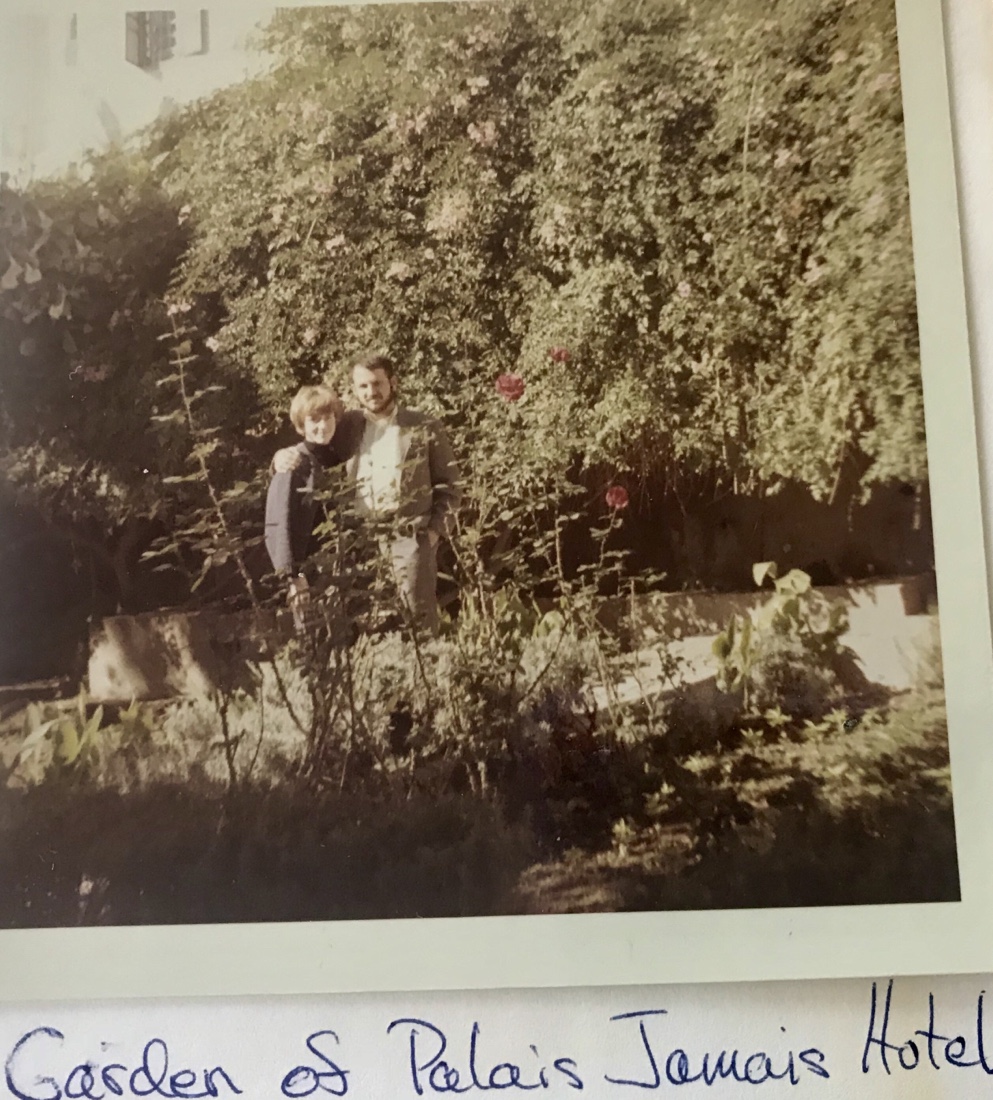
A year or so after the trip, we visited Ruth and Guy in their home in California. That evening we learned that the highlight of Guy’s life, or at least of his business career, was the fact that after Robert Kennedy‘s assassination in California in June of 1968, Guy’s funeral home was selected to receive and embalm the body. He talked about this with considerable relish. Though it certainly seemed morbid to us, he was so genuinely enthused by the professional experience and accolade that we listened intently.
At the time of our trip in January, 1968, Morocco, and particularly Marrakech, was far and away the most exotic place that Carol and I had ever traveled to. Here are a couple badly faded and mediocre at best photographs of the market (souk) in Marrakech. 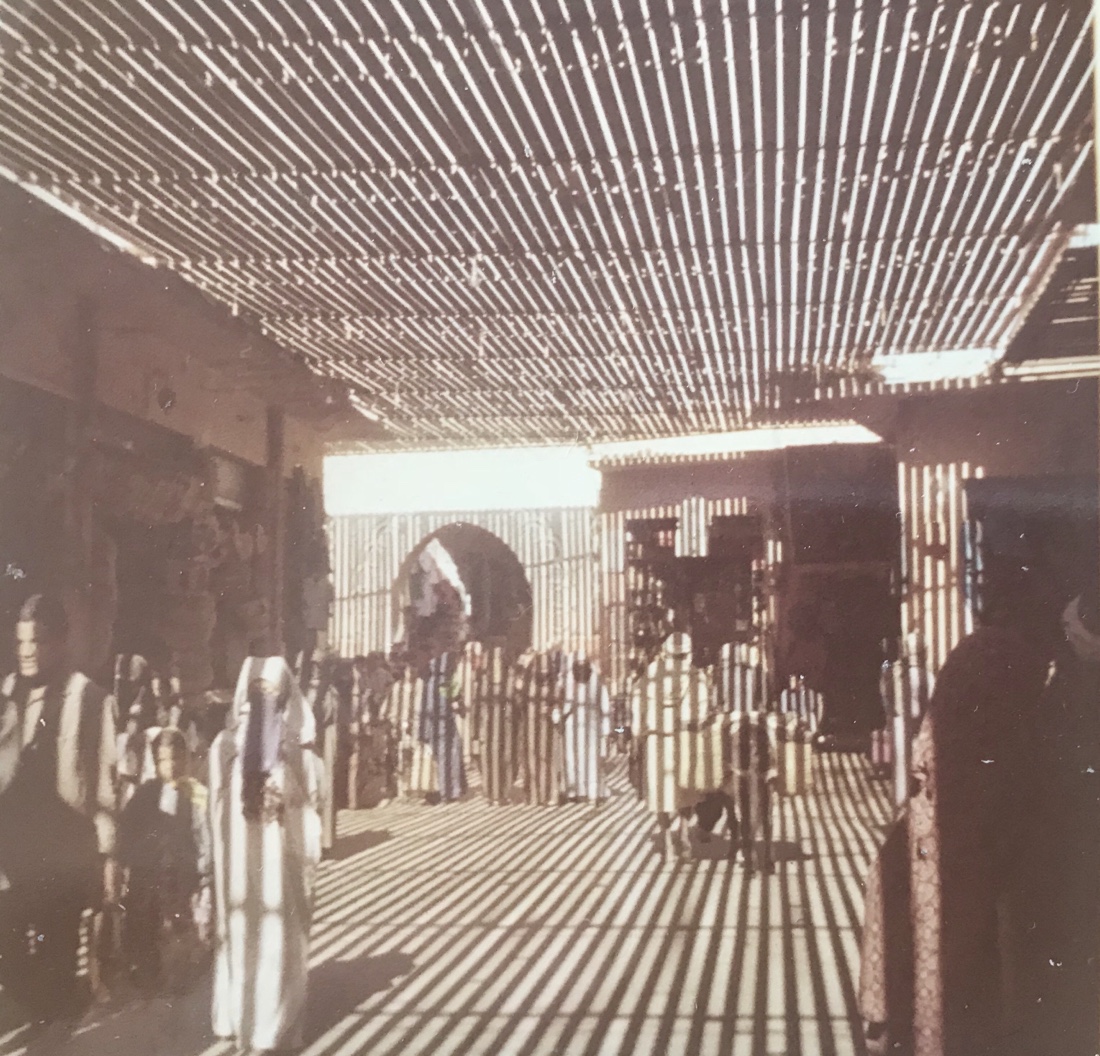 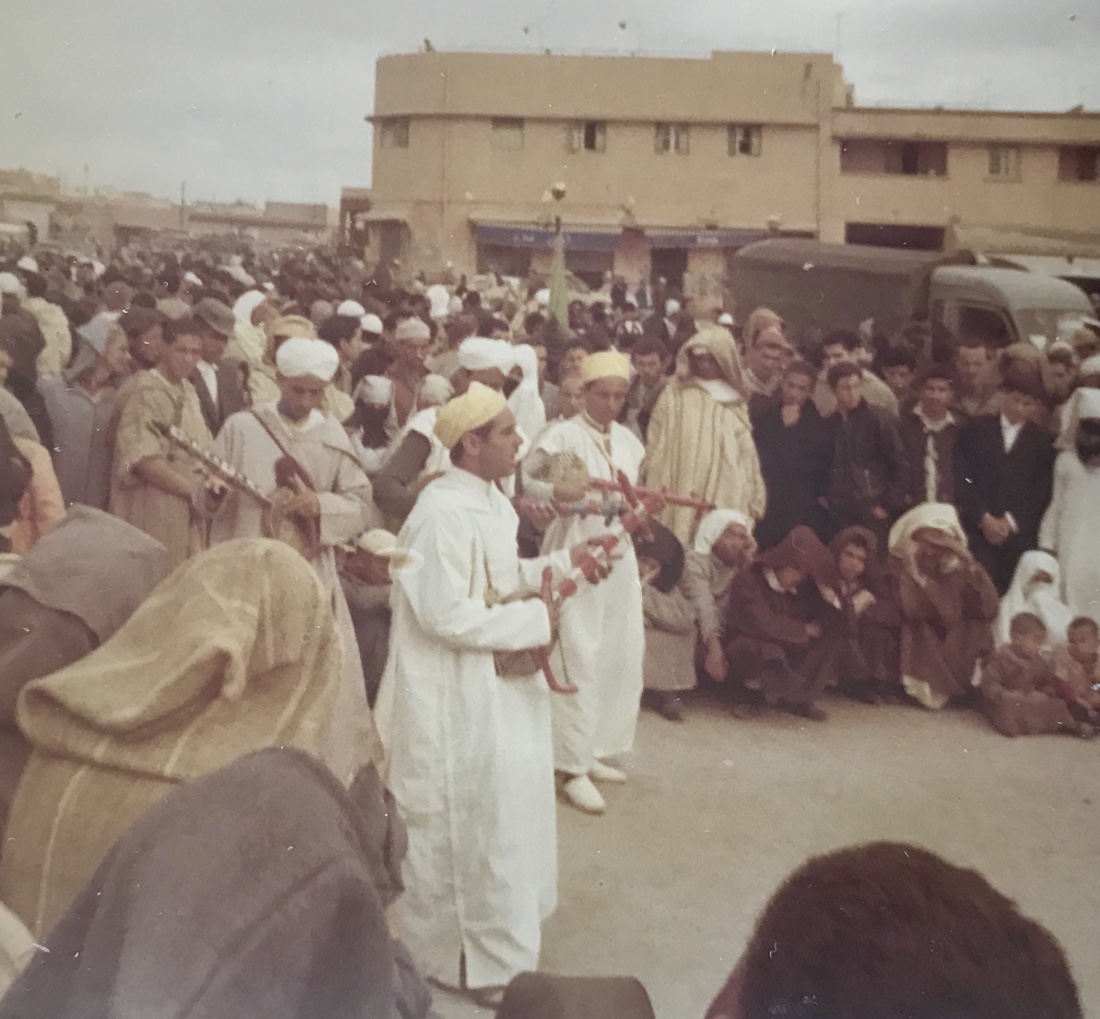
Having traveled very widely since then, it will be extremely interesting to see how exotic Morocco seems to us now and whether the souk at Marrakech still seems exotic, or whether it seems, “ho-hum, just another market.”
Here are a couple more photos from the 1968 trip.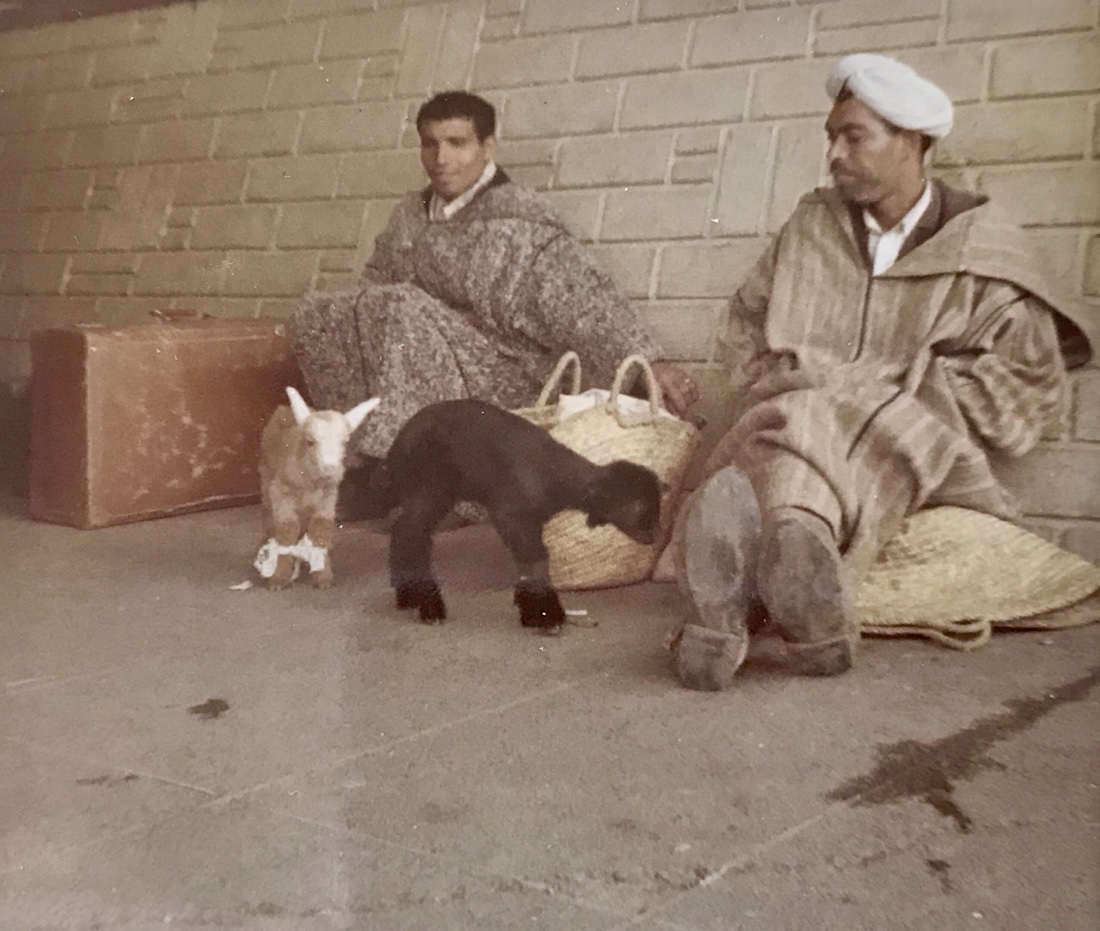 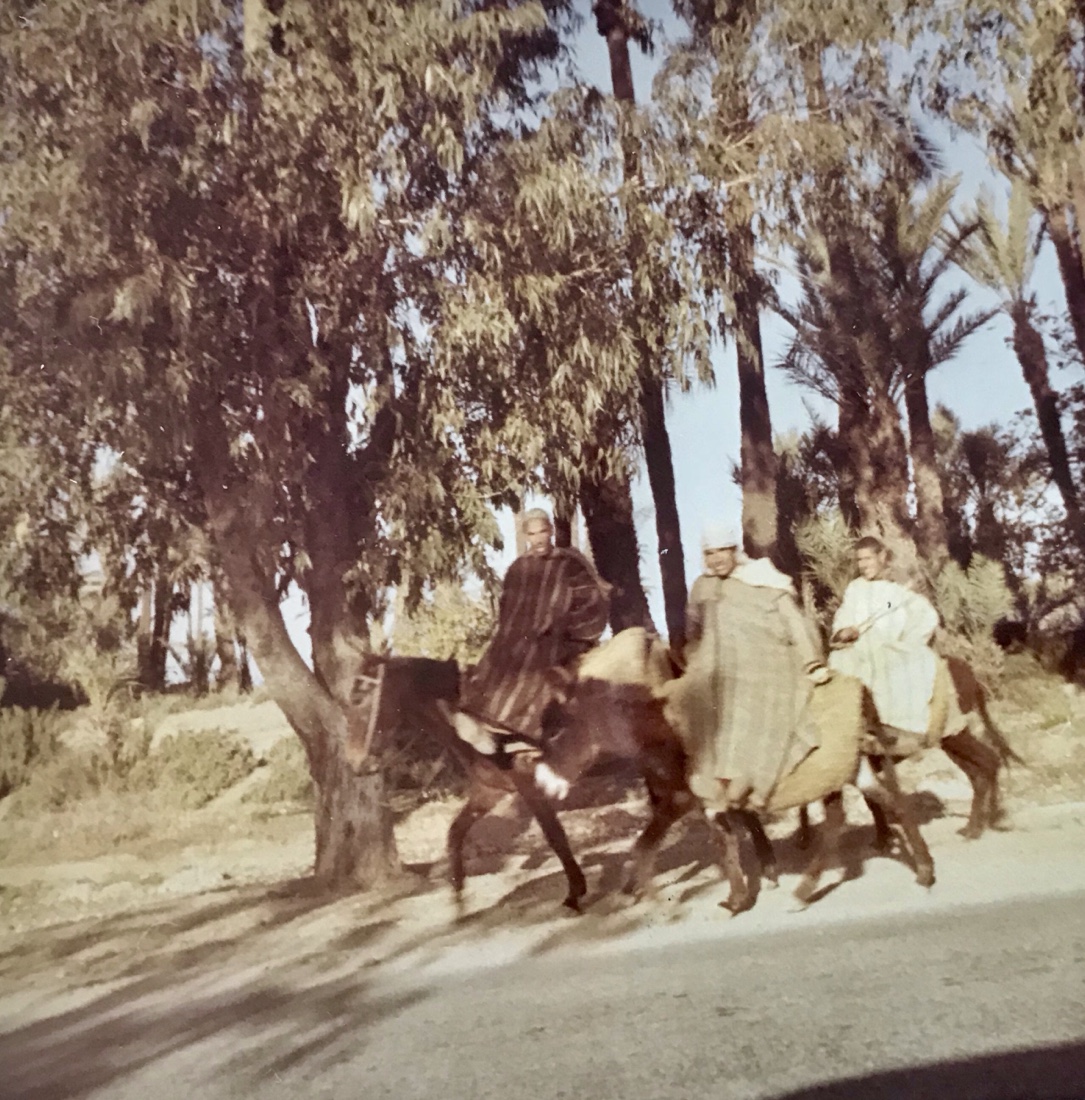
We rarely return to places we’ve been, preferring instead to explore new territory. In fact, we hadn’t intended to go back to Morocco this March, either, and were exploring several other destination options with another couple. In the midst of our exploration, we ran into a former neighbor, Judy Gaynor at a Chicago Humanities Festival progam, who said that one of her sons, Rick Gaynor, had been working in Morocco for a couple years. After talking to Judy, I said to Carol, “let’s go back to Morocco, we haven’t been there for fifty years.” After some discussion, Carol agreed and so we’re off in a couple days on what we both think will be an exciting trip, back in time. Had we not run into Judy, I’m sure we would not be taking this trip. Stuff like that happens all the time when you travel.
As it turned out that the friends we were intending to travel with could not make it after all, Carol and I will be going on our own, and that suits us just fine. Happy to have you along with us, though.
January 13
Initially, I hadn’t intended to blog about our Jamaica trip. The trip was so unlike the other trips I’ve blogged about–most recently (in reverse order) India; Ghana and Botswana: and Thailand, Laos and Cambodia–that it hardly seemed like a vacation. But, on reflection, I’ve decided that a vacation does not need to be exotic to qualify. It’s enough if the trip causes us to vacate (temporarily, of course) our normal life pattern. And, certainly, Jamaica did that.
Were it not for our friend, Kay, Carol and I would never travel to Jamaica. It’s not our kind of destination. A large cruise ship anchoring 100 yards off the beach at our hotel and a town laden with cheap souvenir shops is not our cup of tea, Laying on the beach is not something we love to do. And, as Kay said to us, Jamaica is a young people’s place. Even the music, which Carol and I do like, is too loud and weed-infested for our taste (though we don’t regret finding that out ourselves, first hand).
Culturally, Jamaica is certainly different than what we are used to. The pace is slower, the sports different (cricket and dominoes) and the language, though English, is often difficult to follow, because of the accents and the cadence, and sometimes the words themselves. I suspect that Carol and I will be saying, “ya mahn” to one another for same time. And the patties (pahties) we ate in Ocho Rios were a big, cultural step up from McDonalds.
For me, the highlight of the trip was the mornings and evenings that we spent talking to Kay on her lovely veranda, over coffee, breakfast, drinks or ice cream. Related and similar to that was meeting her friends–the dominoes players, the entertainers on the veranda on Saturday morning, her Fulbright fellow tenant, Abigail, lunch at Iva’s house with her guests and dinner with Pearnell. As we’d expect, Kay surrounds herself with a diverse group of interesting friends, and it’s fun to be with them.
I can already tell that, in retrospect, there will be many moments that we’ll laugh about–a 2-hour drive to see shimmering water, a cricket match at which a loud Australian boor glommed on to three Jamaican men who were too polite to tell him to “screw off,” a play which was not very good, which we could hardly follow, loud concerts at which we almost got contact highs and dominoes being slapped down emphatically and loudly on a table. And, there’ll also be what I hope is our last flight on DiSpiriting Airlines. Vacations survive as memories, and we’ll have more than our share of those.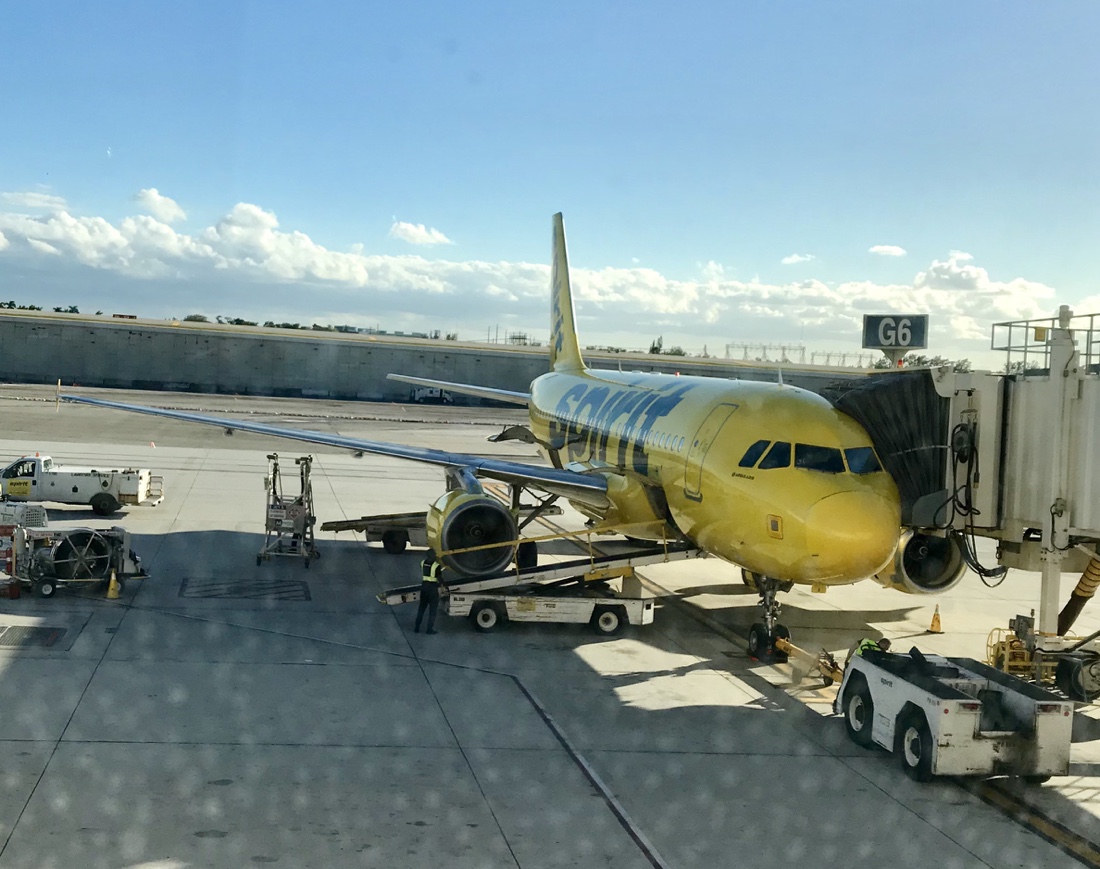
Of things we “did” (other than sitting on Kay’s veranda), the highlight was the Saturday morning entertainment on the veranda, though walking in the forest, cricket, dominoes, paying tribute at the Bob Marley Museum and the excellent Indian meal we had in Ocho Rios were also good fun. There were other things we might have commented on, were we looking more for cultural differences–people selling fresh fish by the roadside, the poetic road signs (“Protect your head and don’t be dead”–wear your helmet–or “Don’t drink and drive, stay alive.”), so there’s a potential career in roadside poetry for Carol, if we should retire to Jamaica.
Of course, escaping Chicago this time of year is a big plus. And being able to visit with Brandeis friends in Florida was a great bonus for us. (We saw the Pérez Art Museum yesterday, which had a wonderful exhibit about Cristo’s wrapping of the islands in Key Biscayne in pink in 1983.)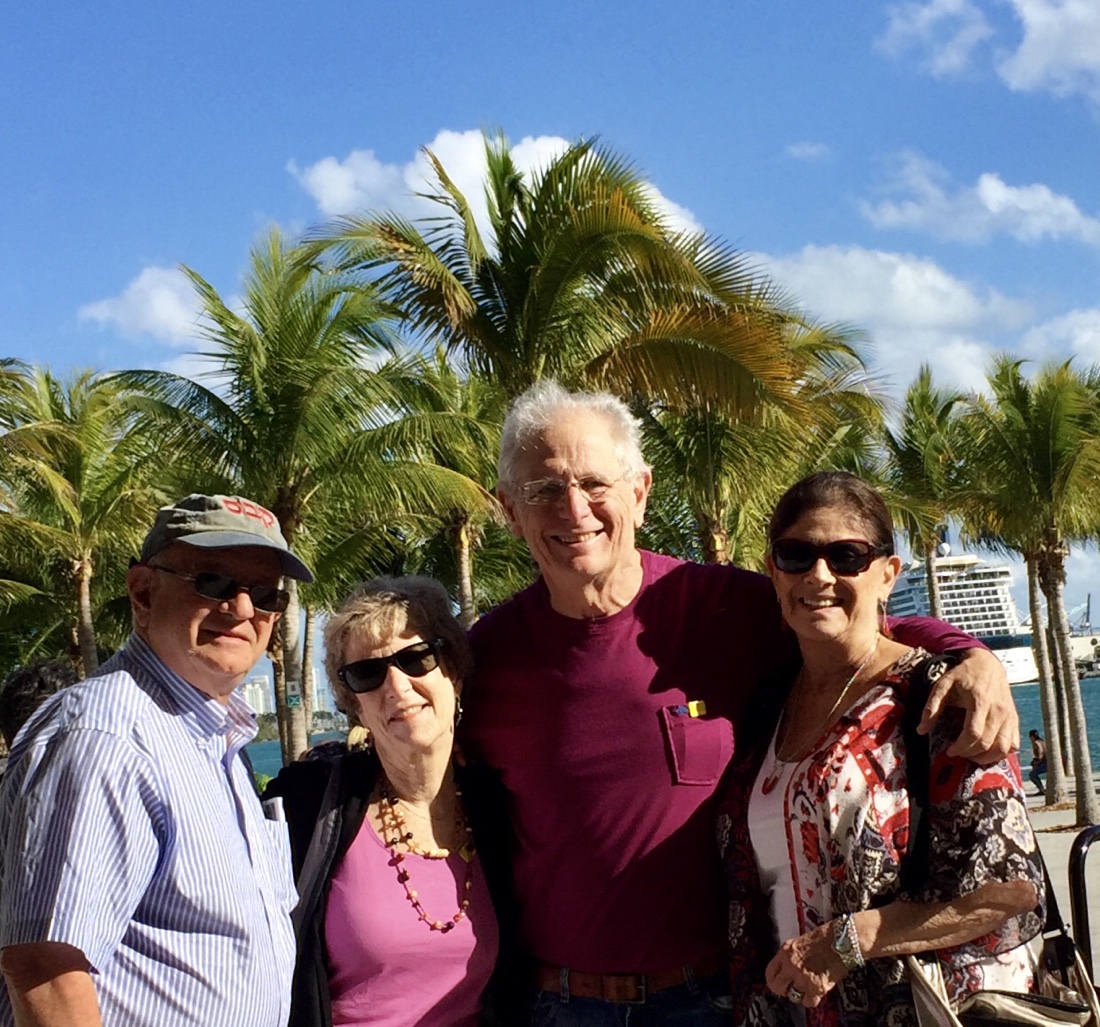 
So, it’s not Africa or India, but Jamaica was a welcome respite. For us, a vacation. But, perhaps, not every vacation is worth blogging about. So, I’d be interested to hear, honestly, whether you felt it was worth bothering you about all this. And, if not, cheer up, I promise you exotic in March.
January 10 and 11
January 10
Breakfast at the hotel, then read and relax by the pool, witnessing some photo ops of young ladies with distinctive hair styles.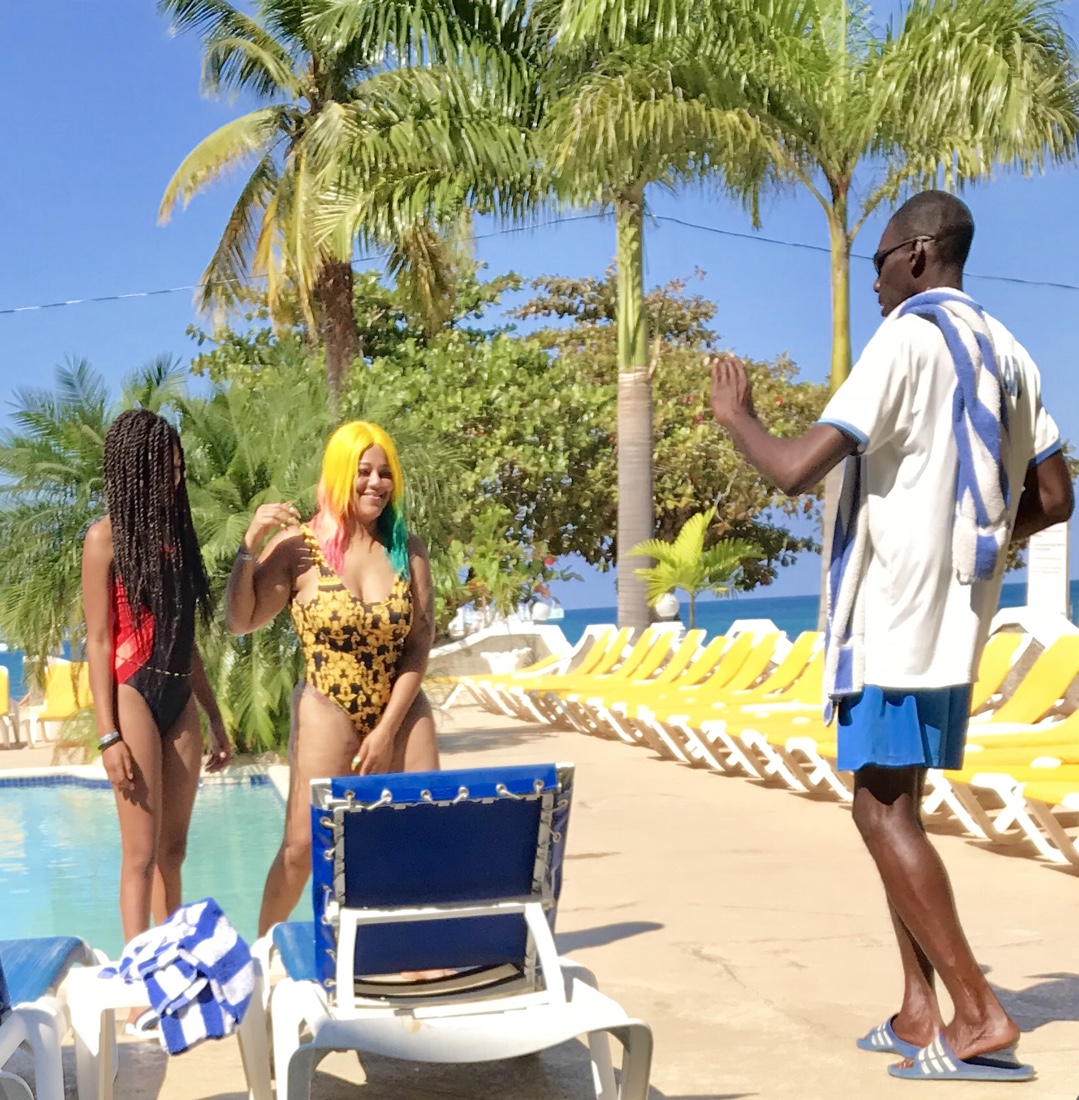
Gilbert picks us up (an hour late) and we drive back to Kingston (through lovely mountain scenery), where we have lunch at Kay’s and rest for the evening’s activities, dinner at an Indian restaurant called Tamarind, which was excellent. And then a play, written by a playwright, Basil Dawkins, who we had met at the veranda talent gathering last Saturday, called Maas Mat Comes to Town, at the Little, Little Theater.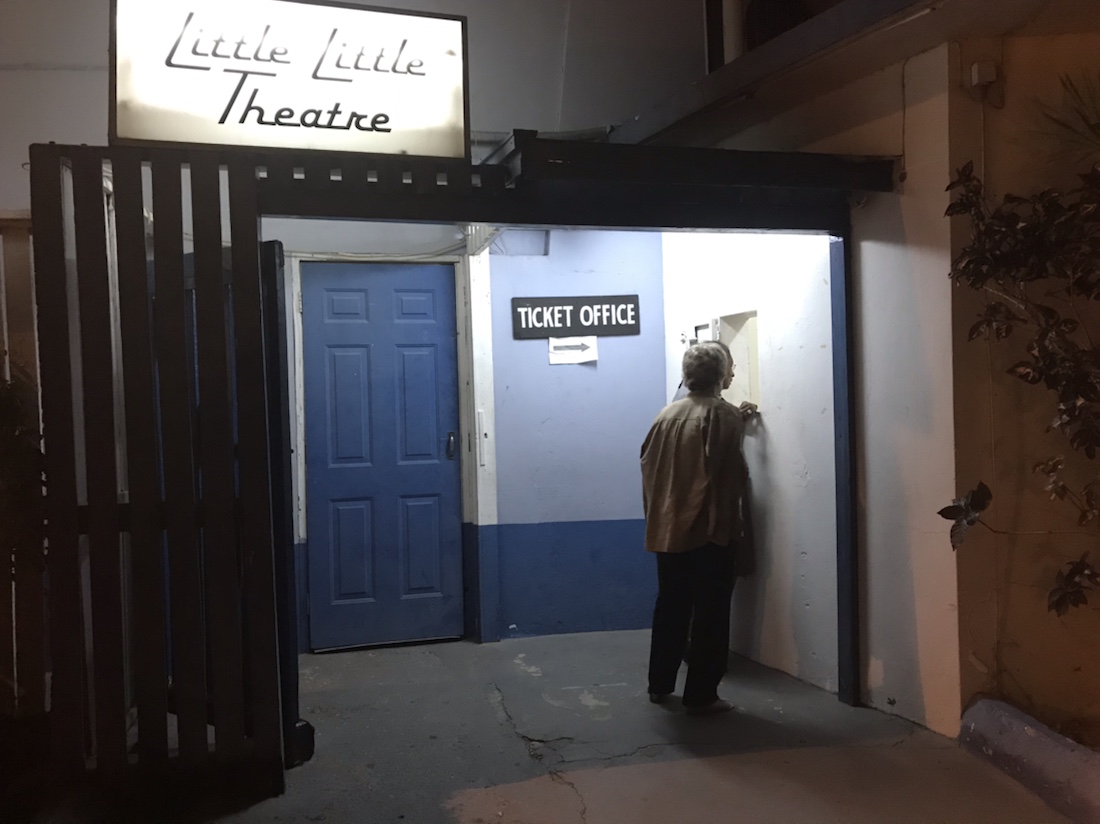
Neither Carol nor Kay liked the play, said it needed considerable work. I could not follow the dialect, so I spent the second act reading Michelle outside the theater.
We returned to Kay’s veranda for some excellent ice cream, to finish off the day.
January 11
Started off the day where we ended last night, on Kay’s veranda, for coffee, an omelette and some relaxing, enjoying the view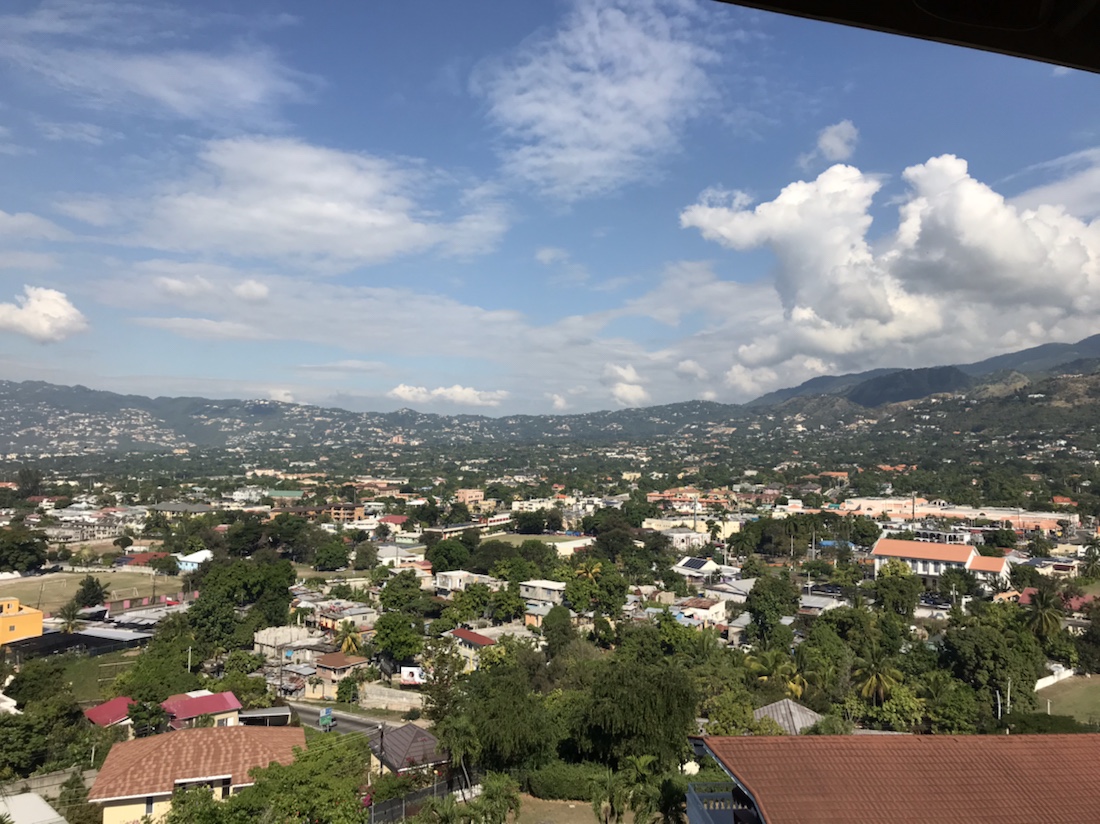
before leaving for the airport (Kay driving us) around 11 for our 2:10 flight, allowing plenty of time for Spirit Airlines’ storied inefficiency.
We were not disappointed in our expectation of inefficiency by Spirit. I’ll spare you the details of what started with their inability to find Carol’s reservation, requiring her to buy another ticket yesterday, and their miraculously finding that reservation today, thus (hopefully) causing them to refund the amount of the second purchase, and continued to their charging for everything imaginable. In the end, I asked the lady at the counter whether there was a separate charge for a seatbelt. (There is not, yet, but I imagine the ticket lady pumping this suggestion into management, and being rewarded for her creativity.). In short, flying Spirit is dispiriting.
But, we made it, and were picked up at the airport by Len and Elyse, and had an excellent dinner with them and my other Florida college buddy, Phil Paul, and his wife, Leslie. I did manage to get into an argument with the manager of the restaurant over their failure adequately to disclose the addition of an 18% tip and their pouring a glass of wine from a bottle that we had rejected as unacceptable. Just a little spice added to the evening.
|
|








 Back to the hotel to sleep and begin to prepare for tomorrow morning’s takeoff.
Back to the hotel to sleep and begin to prepare for tomorrow morning’s takeoff.















